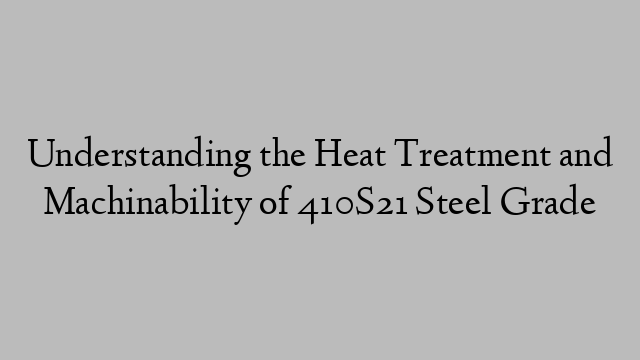Address
304 North Cardinal St.
Dorchester Center, MA 02124
Work Hours
Monday to Friday: 7AM - 7PM
Weekend: 10AM - 5PM
Address
304 North Cardinal St.
Dorchester Center, MA 02124
Work Hours
Monday to Friday: 7AM - 7PM
Weekend: 10AM - 5PM

Stainless steel is a popular metal in various industries due to its corrosion resistance, durability, and overall strength. One specific grade, 410S21, is widely used in applications where high levels of strength and corrosion resistance are required. Understanding the heat treatment and machinability of this steel grade is essential for ensuring its optimal performance and longevity.
Heat treatment is a critical process in the manufacturing of 410S21 stainless steel. This involves heating the steel to a specific temperature, holding it at that temperature, and then cooling it at a controlled rate. The goal of heat treatment is to enhance the mechanical properties of the steel, such as hardness, toughness, and machinability. For 410S21 steel, the recommended heat treatment process is annealing, which involves heating the steel to a temperature of 815-900°C and then cooling it slowly in the furnace.
Proper heat treatment of 410S21 steel is essential for achieving the desired mechanical properties. Overheating or rapid cooling can result in a loss of corrosion resistance, ductility, and toughness, while underheating may not fully refine the microstructure of the steel. It is important to follow the recommended heat treatment process to ensure that the steel exhibits the desired properties for its intended application.
In addition to heat treatment, machinability is another important factor to consider when working with 410S21 stainless steel. Machinability refers to the ease with which a material can be cut, shaped, or formed using various machining processes, such as drilling, milling, and turning. The machinability of 410S21 steel is influenced by factors such as its chemical composition, microstructure, and heat treatment.
410S21 steel is known for its relatively good machinability, especially in the annealed condition. During the annealing process, the steel’s microstructure is refined, resulting in improved machinability. However, 410S21 steel can become more difficult to machine when it is hardened through heat treatment. In such cases, it is important to use the appropriate cutting tools and machining parameters to achieve the desired results.
To ensure the best machinability of 410S21 steel, it is important to optimize the machining processes and take into account factors such as cutting speed, feed rate, and tool material. Using the right cutting tools, such as carbide inserts, and employing the appropriate cutting parameters can help to achieve efficient material removal and surface finish.
In conclusion, understanding the heat treatment and machinability of 410S21 stainless steel is essential for ensuring the optimal performance and longevity of this steel grade in various applications. Proper heat treatment, such as annealing, is crucial for achieving the desired mechanical properties, while optimizing machining processes can ensure efficient material removal and surface finish. By taking these factors into consideration, manufacturers and engineers can maximize the performance of 410S21 steel in a wide range of industrial applications.